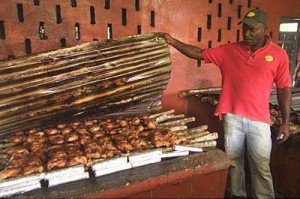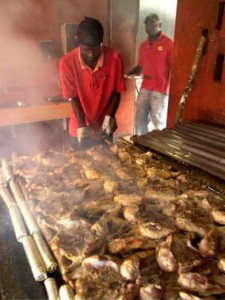“Cookin’ Jerk on de Barbacoa, Mon!”
Jamaica—a tiny, but proud jewel in the center of the Caribbean. It was once the home of Christopher Columbus’ family estate, and, of much importance to BBQ aficionados, the birthplace of the word “barbecue.”
The word “barbecue” is believed by many to have evolved from the Taino Indian word barbacoa, meaning a simple wooden meat-smoking apparatus. Perhaps Chris himself watched strips of meat slowly cooking on a frame of green wood sticks over a smoky fire.
Today pork, chicken, fish, and shellfish, cooked in the traditional manner over green wood, find their way into various local dishes. Allspice and thyme are typical seasonings in Jamaican cooking, and the super-hot Scotch bonnet pepper adds fiery punch to almost everything.
But it’s jerk that put Jamaica on the BBQ culinary map of the world.
Jamaican restaurants are happily filled with jerks. Jerks can also be found in home kitchens, roadside eateries, cafes, and even in the pricey four-star bistros. Jerks are everywhere.
No…not those kind of jerks! We’re talking about jerk chicken, jerk pork, jerk beef, jerk mutton, jerk goat, jerk fish, jerk vegetables, jerk soup, and even jerk chicken salad sandwiches.
The word “jerk” is used as both a noun to describe the seasoning applied to food that is smoked for a long time, and as a verb to explain the process of slow cooking that is used.
There are literally thousands of different jerk spice recipes, but everyone agrees on two key ingredients: allspice (Jamaican pimento) and habanero (Scotch bonnet) peppers. You need both for a jerk. Then, depending on your recipe, you can add cinnamon, cloves, nutmeg, thyme, garlic, sugar, salt, and pepper, or any other spice you fancy.
Jerk cooking was first conceived by the Maroons, slaves brought to Jamaica to work the fields and farms. They brought their African spices and cooking techniques to the island, and thus a wonderful cooking style, plus a huge and profitable spice and cooking industry, was born.
Jerk foods are rubbed with the jerk seasoning, then cooked over a fire, or coals, at a low temperature, with green or soaked wood added to make a lot of smoke. Remember that barbacoa wood frame?
Montego Bay (MB) and Ocho Rios (OR), the two most popular tourist stops, are loaded with jerk restaurants. I’ll list here some of my favorites; all of these serve delicious Jamaican non-jerk dishes too:
Scotchie’s (MB and OR) – the most famous jerk restaurant on the island, serving tons of chicken, fish, potatoes and yams cooked daily over green wood.
Calabash Restaurant (MB) – grilled she crab or curried goat.
Pork Pit (MB) – jerk chicken and pork ribs with pigeon peas and rice.
Pier 1 (MB) – jerk barbecued lobster and shrimp kebabs.
Sugar Mill (MB) – smoked marlin or lobster in Pickapeppa sauce.
Island House (OR) – jerk chicken burgers.
Village Jerk Center (OR) – jerk sold by weight: pork, beef, seafood and super “festival” (similar to hush puppies or fried polenta).
Jerk and jerk-flavored foods are cooked everywhere in pots, pans, and skillets as well. I had jerk goat, jerk salted fish, and even jerk ackee.
Ackee, Jamaica’s national fruit, is one of the strangest edible plants on the planet. The fruit seeds turn red on reaching maturity and split open under the hot sun. The ackees are then harvested and the yellowish-white portion removed and cleaned, then cooked. Cooked ackee looks and tastes like scrambled eggs, and is quite delicious. It is most often served with salt cod.
The secret to jerk cooking, as with most cooking, is the use of fresh, seasonal, and local ingredients. The Scotch bonnet and other peppers, allspice and pimento, coconuts and coconut milk, fresh fruits and fruit juices, and very fresh meats, fish and poultry, are key essentials to the best jerk dishes.
I share here a few recipes from my recent travels to Jamaica where I filmed two episodes of my Barbecue America – The World Tour series.
As the Jamaicans say: “Mek haste, let’s run a boat, Im des fi dat barbecoa, Mon. Irie?”
(“Hurry up, let’s get together and cook, I’m desperate for some barbecue, Mon. Alright?”)
Recipes:
JAMAICAN GOAT CURRY
Goat is a popular island meat for jerking. Its stronger flavor works well with the rich seasonings of the jerk rub.
3 lbs. goat meat, cut into 1”-1 1/2” inch pieces
1/4 cup cider vinegar
2 cups water
Jerk rub:
1 small Scotch bonnet pepper, seeded and minced
4 oz. curry powder
1 oz. freshly ground black pepper
2 tablespoons sea salt
4 sprigs fresh thyme (or 1 tablespoon dried)
1/2 teaspoon allspice
1/8 teaspoon ground cloves
1 1/2 cups water
1 1/2 cup coconut milk
1 large onion, roughly chopped
2 cups thickly sliced carrots
2 garlic cloves, minced
1 oz. vegetable oil
1 lb. peeled, cubed white potatoes
Wash goat meat in vinegar-water. Pat dry and rub with the jerk rub, put in sealable plastic bag and let sit for 4-5 hours in refrigerator.
Remove the meat from the refrigerator and bring to room temperature (about 20 minutes).
In a cast iron or heavy saucepan, or wok, on bbq grill or side burner over high heat, heat the oil until it just begins to smoke.
Place the spiced meat in the saucepan, turning frequently to brown all sides.
Add the water and coconut milk to the pot, then add the onions, carrots, and garlic, turn down the heat and simmer for 35-40 minutes, making sure meat is always at least half-covered with liquid, adding small amounts of water as necessary.
Add cubed potatoes and cook covered for additional 20 minutes on very low simmer.
Sprinkle on chopped green onions and serve.
Serves 4 to 6
Grilled Spicy Shrimp with Lime
Fresh shrimp should be prepared on the same day they are purchased. To store them before cooking, rinse the shrimp in cold running water and pat dry. Wrap in two to three damp paper towels, place in a re-sealable plastic bag, and refrigerate.
1/2 cup chopped yellow onion
1 jalapeño, stemmed, seeded, chopped
3 tablespoons white wine vinegar
2 tablespoons soy sauce
2 tablespoons canola oil
1/2 teaspoon Krista’s Jamaican Hot Sauce (or your favorite hot sauce)
1/2 teaspoon ground allspice
1/4 teaspoon granulated garlic
1/4 teaspoon cinnamon
1/4 teaspoon kosher salt
1/4 teaspoon freshly ground black pepper
1/8 teaspoon nutmeg
40 large (21/25) shrimp (about 2 pounds), shells on, deveined
2 limes, cut into quarters for serving
In a food processor or blender, combine the onion, jalapeño, vinegar, soy sauce, oil, hot sauce, allspice, garlic, cinnamon, salt, pepper, and nutmeg. Process until smooth.
Put the shrimp in a large re-sealable plastic bag. Pour in the marinade, press out the air, and seal the bag. Shake to coat. Transfer the bag to a large bowl and refrigerate for 1 to 2 hours.
Preheat a charcoal or gas grill to 375 degrees F. Make sure the grill rack is clean, and oil it thoroughly with nonstick cooking spray.
Remove the shrimp from the bag, discard the marinade, and thread the shrimp lengthwise on skewers.
Transfer the shrimp to the prepared grill rack and grill over direct heat, turning skewers only once, until the shrimp are firm to the touch, pink all over, and just opaque, 3 to 4 minutes total.
To serve, transfer to a warm serving platter, squeeze a little fresh lime juice over the shrimp, and serve immediately.
Serves 4 to 6
Jerk Chicken with Pineapple-Mango Salsa
This recipe for jerk sauce is fiery but not incendiary, full of flavor, and worth the effort to make it. There are as many Jamaican recipes for jerk as there are Jamaicans; I settled on this as one the best of the best. Serve with big iced bottles of Jamaican Red Stripe beer.
1/3 cup coarsely chopped shallot
4 green onions, green and white parts, chopped
1/2 cup olive oil
1/2 cup water
Juice of 2 limes
1/4 cup soy sauce
1/2 to 1 Scotch bonnet chile, stemmed, seeded, and chopped
3 large cloves garlic, coarsely chopped
1 cup ketchup
2 tablespoons allspice
1 teaspoon nutmeg
1 teaspoon cinnamon
2 tablespoons ground ginger
1 teaspoon dried thyme
4-6 (4 to 6 oz.) skinless, bone-in chicken breasts
1 cup chopped fresh pineapple
1 cup chopped fresh mango
2 tablespoons chopped onion
1 tablespoon minced jalapeño
1/4 cup chopped fresh cilantro
1/4 cup freshly squeezed lime juice
Salt
Freshly ground black pepper
In a food processor or blender, combine the shallots, green onions, oil, water, lime juice, soy sauce, Scotch bonnet, garlic, ketchup, allspice, nutmeg, cinnamon, ginger, and thyme and process until a smooth paste forms. Set aside.
Wash the chicken breasts and pat dry. Using rubber gloves, cover each breast with the jerk paste. Place the chicken in a re-sealable plastic bag and refrigerate for 4 to 8 hours.
Prepare a charcoal or gas barbecue for indirect grilling, placing a drip pan under the cool side of the grill rack. Preheat to 350 degrees F. Make sure the grill rack is clean, and oil it thoroughly with nonstick cooking spray.
Remove the chicken from the bag and transfer to the prepared grill rack over direct heat. Cook for 5 minutes per side, then move the chicken to the cool side of the grill and cook for 10 to 15 minutes longer per side, until the internal temperature reaches 160˚F. Remove the chicken from the grill and let stand, covered, for 10 minutes.
Meanwhile, prepare the salsa by combining the pineapple, mango, onion, jalapeño, cilantro, and lime juice in a food processor and pulsing 3 or4 times until the ingredients are chopped, but still chunky. Pour into a bowl, season with salt and pepper, and set aside.
Serve each breast topped with a generous portion of salsa.
Serves 4 to 6“Cookin’ Jerk on de Barbacoa, Mon!”
“Cookin’ Jerk on de Barbacoa, Mon!”
By Rick Browne, PH.B.
Recipes
Jamaican Goat Curry
Grilled Spicy Shrimp with Lime
Jerk Chicken with Pineapple-Mango Salsa
The word “barbecue” is believed by many to have evolved from the Taino Indian word barbacoa, meaning a simple wooden meat-smoking apparatus. Perhaps Chris himself watched strips of meat slowly cooking on a frame of green wood sticks over a smoky fire.Jamaica—a tiny, but proud jewel in the center of the Caribbean. It was once the home of Christopher Columbus’ family estate, and, of much importance to BBQ aficionados, the birthplace of the word “barbecue.”
Today pork, chicken, fish, and shellfish, cooked in the traditional manner over green wood, find their way into various local dishes. Allspice and thyme are typical seasonings in Jamaican cooking, and the super-hot Scotch bonnet pepper adds fiery punch to almost everything.
But it’s jerk that put Jamaica on the BBQ culinary map of the world.
Jamaican restaurants are happily filled with jerks. Jerks can also be found in home kitchens, roadside eateries, cafes, and even in the pricey four-star bistros. Jerks are everywhere.
No…not those kind of jerks! We’re talking about jerk chicken, jerk pork, jerk beef, jerk mutton, jerk goat, jerk fish, jerk vegetables, jerk soup,
and even jerk chicken salad sandwiches.
The word “jerk” is used as both a noun to describe the seasoning applied to food that is smoked for a long time, and as a verb to explain the process of slow cooking that is used.
There are literally thousands of different jerk spice recipes, but everyone agrees on two key ingredients: allspice (Jamaican pimento) and habanero (Scotch bonnet) peppers. You need both for a jerk. Then, depending on your recipe, you can add cinnamon, cloves, nutmeg, thyme, garlic, sugar, salt, and pepper, or any other spice you fancy.
Jerk cooking was first conceived by the Maroons, slaves brought to Jamaica to work the fields and farms. They brought their African spices and cooking techniques to the island, and thus a wonderful cooking style, plus a huge and profitable spice and cooking industry, was born.
Jerk foods are rubbed with the jerk seasoning, then cooked over a fire, or coals, at a low temperature, with green or soaked wood added to make a lot of smoke. Remember that barbacoa wood frame?
Montego Bay (MB) and Ocho Rios (OR), the two most popular tourist stops, are loaded with jerk restaurants. I’ll list here some of my favorites; all of these serve delicious Jamaican non-jerk dishes too:
Scotchie’s (MB and OR) – the most famous jerk restaurant on the island, serving tons of chicken, fish, potatoes and yams cooked daily over green wood.
Calabash Restaurant (MB) – grilled she crab or curried goat.
Pork Pit (MB) – jerk chicken and pork ribs with pigeon peas and rice.
Pier 1 (MB) – jerk barbecued lobster and shrimp kebabs.
Sugar Mill (MB) – smoked marlin or lobster in Pickapeppa sauce.
Island House (OR) – jerk chicken burgers.
Village Jerk Center (OR) – jerk sold by weight: pork, beef, seafood and super “festival” (similar to hush puppies or fried polenta).
Jerk and jerk-flavored foods are cooked everywhere in pots, pans, and skillets as well. I had jerk goat, jerk salted fish, and even jerk ackee.
Ackee, Jamaica’s national fruit, is one of the strangest edible plants on the planet. The fruit seeds turn red on reaching
maturity and split open under the hot sun. The ackees are then harvested and the yellowish-white portion removed and cleaned, then cooked. Cooked ackee looks and tastes like scrambled eggs, and is quite delicious. It is most often served with salt cod.
I share here a few recipes from my recent travels to Jamaica where I filmed two episodes of my Barbecue America – The World Tour series.The secret to jerk cooking, as with most cooking, is the use of fresh, seasonal, and local ingredients. The Scotch bonnet and other peppers, allspice and pimento, coconuts and coconut milk, fresh fruits and fruit juices, and very fresh meats, fish and poultry, are key essentials to the best jerk dishes.
As the Jamaicans say: “Mek haste, let’s run a boat, Im des fi dat barbecoa, Mon. Irie?”
(“Hurry up, let’s get together and cook, I’m desperate for some barbecue, Mon. Alright?”)
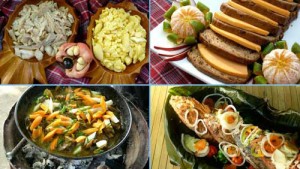
Jamaican foods: (clockwise from top left) Salt fish and ackee, Easter Bun and cheddar cheese, fried fish with vegetables, curried goat cooked on a wheel rim barbecue.
JAMAICAN GOAT CURRY
Goat is a popular island meat for jerking. Its stronger flavor works well with the rich seasonings of the jerk rub.
3 lbs. goat meat, cut into 1”-1 1/2” inch pieces
1/4 cup cider vinegar
2 cups water
Jerk rub:
1 small Scotch bonnet pepper, seeded and minced
4 oz. curry powder
1 oz. freshly ground black pepper
2 tablespoons sea salt
4 sprigs fresh thyme (or 1 tablespoon dried)
1/2 teaspoon allspice
1/8 teaspoon ground cloves
1 1/2 cups water
1 1/2 cup coconut milk
1 large onion, roughly chopped
2 cups thickly sliced carrots
2 garlic cloves, minced
1 oz. vegetable oil
1 lb. peeled, cubed white potatoes
Wash goat meat in vinegar-water. Pat dry and rub with the jerk rub, put in sealable plastic bag and let sit for 4-5 hours in refrigerator.
Remove the meat from the refrigerator and bring to room temperature (about 20 minutes).
In a cast iron or heavy saucepan, or wok, on bbq grill or side burner over high heat, heat the oil until it just begins to smoke.
Place the spiced meat in the saucepan, turning frequently to brown all sides.
Add the water and coconut milk to the pot, then add the onions, carrots, and garlic, turn down the heat and simmer for 35-40 minutes, making sure meat is always at least half-covered with liquid, adding small amounts of water as necessary.
Add cubed potatoes and cook covered for additional 20 minutes on very low simmer.
Sprinkle on chopped green onions and serve.
Serves 4 to 6
Grilled Spicy Shrimp with Lime
Fresh shrimp should be prepared on the same day they are purchased. To store them before cooking, rinse the shrimp in cold running water and pat dry. Wrap in two to three damp paper towels, place in a re-sealable plastic bag, and refrigerate.
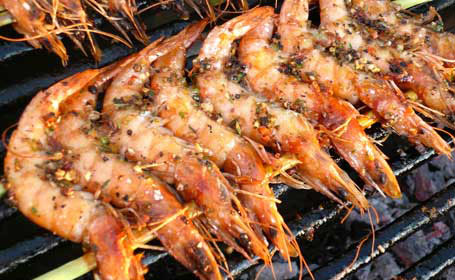
1/2 cup chopped yellow onion
1 jalapeño, stemmed, seeded, chopped
3 tablespoons white wine vinegar
2 tablespoons soy sauce
2 tablespoons canola oil
1/2 teaspoon Krista’s Jamaican Hot Sauce (or your favorite hot sauce)
1/2 teaspoon ground allspice
1/4 teaspoon granulated garlic
1/4 teaspoon cinnamon
1/4 teaspoon kosher salt
1/4 teaspoon freshly ground black pepper
1/8 teaspoon nutmeg
40 large (21/25) shrimp (about 2 pounds), shells on, deveined
2 limes, cut into quarters for serving
In a food processor or blender, combine the onion, jalapeño, vinegar, soy sauce, oil, hot sauce, allspice, garlic, cinnamon, salt, pepper, and nutmeg. Process until smooth.
Put the shrimp in a large re-sealable plastic bag. Pour in the marinade, press out the air, and seal the bag. Shake to coat. Transfer the bag to a large bowl and refrigerate for 1 to 2 hours.
Preheat a charcoal or gas grill to 375 degrees F. Make sure the grill rack is clean, and oil it thoroughly with nonstick cooking spray.
Remove the shrimp from the bag, discard the marinade, and thread the shrimp lengthwise on skewers.
Transfer the shrimp to the prepared grill rack and grill over direct heat, turning skewers only once, until the shrimp are firm to the touch, pink all over, and just opaque, 3 to 4 minutes total.
To serve, transfer to a warm serving platter, squeeze a little fresh lime juice over the shrimp, and serve immediately.
Serves 4 to 6
Jerk Chicken with Pineapple-Mango Salsa
This recipe for jerk sauce is fiery but not incendiary, full of flavor, and worth the effort to make it. There are as many Jamaican recipes for jerk as there are Jamaicans; I settled on this as one the best of the best. Serve with big iced bottles of Jamaican Red Stripe beer.
1/3 cup coarsely chopped shallot
4 green onions, green and white parts, chopped
1/2 cup olive oil
1/2 cup water
Juice of 2 limes
1/4 cup soy sauce
1/2 to 1 Scotch bonnet chile, stemmed, seeded, and chopped
3 large cloves garlic, coarsely chopped
1 cup ketchup
2 tablespoons allspice
1 teaspoon nutmeg
1 teaspoon cinnamon
2 tablespoons ground ginger
1 teaspoon dried thyme
4-6 (4 to 6 oz.) skinless, bone-in chicken breasts
1 cup chopped fresh pineapple
1 cup chopped fresh mango
2 tablespoons chopped onion
1 tablespoon minced jalapeño
1/4 cup chopped fresh cilantro
1/4 cup freshly squeezed lime juice
Salt
Freshly ground black pepper
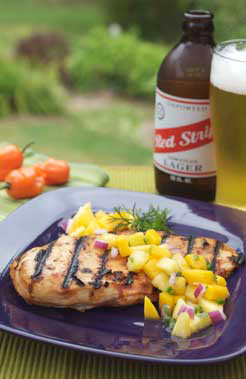
In a food processor or blender, combine the shallots, green onions, oil, water, lime juice, soy sauce, Scotch bonnet, garlic, ketchup, allspice, nutmeg, cinnamon, ginger, and thyme and process until a smooth paste forms. Set aside.
Wash the chicken breasts and pat dry. Using rubber gloves, cover each breast with the jerk paste. Place the chicken in a re-sealable plastic bag and refrigerate for 4 to 8 hours.
Prepare a charcoal or gas barbecue for indirect grilling, placing a drip pan under the cool side of the grill rack. Preheat to 350 degrees F. Make sure the grill rack is clean, and oil it thoroughly with nonstick cooking spray.
Remove the chicken from the bag and transfer to the prepared grill rack over direct heat. Cook for 5 minutes per side, then move the chicken to the cool side of the grill and cook for 10 to 15 minutes longer per side, until the internal temperature reaches 160˚F. Remove the chicken from the grill and let stand, covered, for 10 minutes.
Meanwhile, prepare the salsa by combining the pineapple, mango, onion, jalapeño, cilantro, and lime juice in a food processor and pulsing 3 or4 times until the ingredients are chopped, but still chunky. Pour into a bowl, season with salt and pepper, and set aside.
Serve each breast topped with a generous portion of salsa.
Serves 4 to 6






